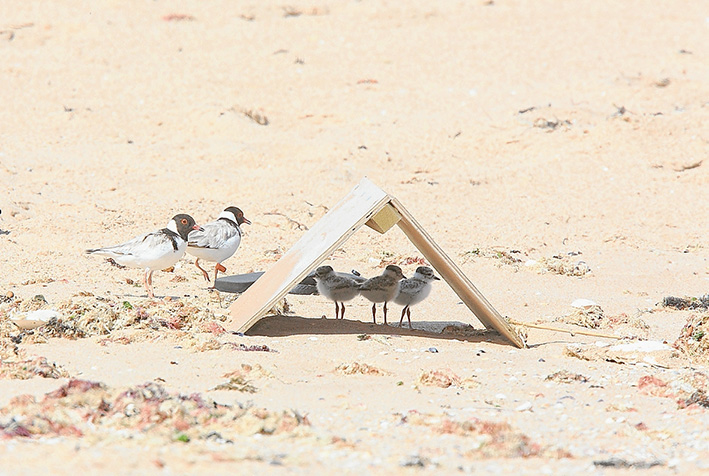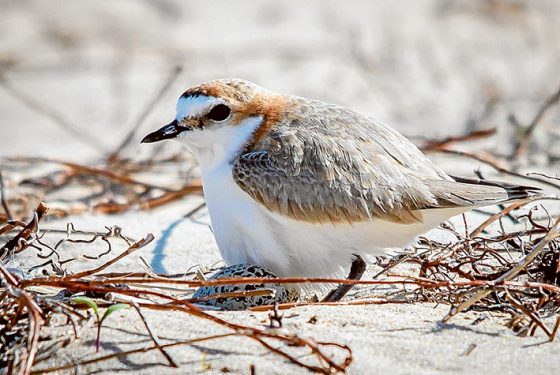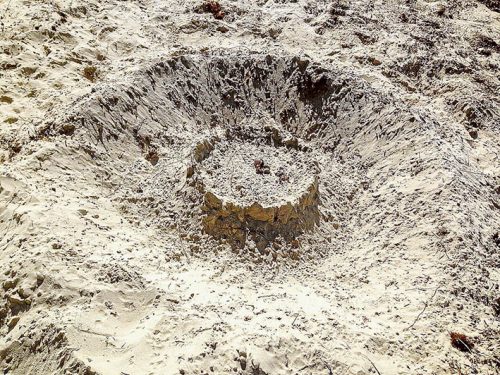

PROTECTORS of the endangered hooded plover are documenting senseless acts by beachgoers that are threatening breeding birds.
The plovers each year struggle to breed on Mornington Peninsula beaches with an ever decreasing number of their chicks ever taking flight.
Dr Grainne Maguire of BirdLife Australia’s beach-nesting birds’ team said data shows that without preventative action hooded plovers will  be extinct in the region “in the next 25 years”.
be extinct in the region “in the next 25 years”.
“There are a suite of threats these birds face. A number of these threats are natural, but it is the human modifications of habitat – weeds and access points – and predator systems such as introduced foxes, super abundant ravens, gulls and magpies and the impacts of disturbance, direct crushing and predation by domestic pets, that are tipping the balance,” she said.
Members of the Friends of the Hooded Plover group have this season erected fences around nests and placed notices asking that the birds be left alone.
Other groups such as the Hastings-based Willum Warrain Aboriginal Association have built shelters under which the plovers and their chicks can seek refuge.
But as soon as the latest breeding season was underway it soon became obvious that thoughtless humans were one of the main dangers threatening the survival of hooded plovers and other small ground nesting seabirds.
Diane Lewis said a woman approached about “allowing her dog to run all over the beach and into the dunes” claimed not to have seen Parks Victoria’s dog restriction signs.
Ms Lewis, president of the Friends of the Hooded Plover group, had been at Rye surf beach watching 12-day-old plover chicks.
“These chicks still have a long way to go, they can’t fly until they are 35 days old, but they can now regulate their own temperature and have the strength to run up to the dry sand to avoid beach goers and their dogs – if they are on a lead,” she said.
Ms Lewis said hot weather created more pressure for plover chicks, with their parents “trying to get them down to the water’s edge to keep them cool”.
Hooded plovers incubating eggs “will be swapping constantly, flying down to the water’s edge to wet their breast feathers and returning to the nest in an effort to keep the eggs at a normal temperature”.
Ms Lewis described the three chicks as “cute balls of fluff standing on legs thinner than a matchstick”.
“Against the odds they have survived through the 28 days of incubation by both parents. They have survived tides, storms, hungry gulls, kestrels and ravens and very sly foxes,” she said.
“They have also survived the few irresponsible dog owners who let their dogs loose in the national park ocean beaches.
“Despite all these threats they are here on the beach, their parents watching out for them, standing guard, telling them when to hide, then calling the coast clear signal.”
Mr Lewis said the first 10 days “are especially critical as those same threats are ever present. The chicks forage for food from day one and keep cool and safe under their parents brooding. When they can, they scurry across the sand to the water’s edge to feel the cool sand and feed under seaweed.
“If they are disturbed, the parents may leave the chicks and lead the threat away. The chicks can starve if they have to hide too long.”
Mr Lewis pleaded for beachgoers to “give the plovers a chance” by staying away from the fenced areas.
“With luck and great care these three chicks may very well be some of the few endangered plovers to fledge and survive this season,” she said.
“When they can fly they have made it, but that’s five weeks after they hatch. Will they be okay? Will they beat the odds and fly?”
Mark Lethlean, a volunteer for Parks Victoria and BirdLife Australia, said the two organisations had extended their work of protecting nesting shorebirds to Western Port, including both hooded plovers and red-capped plovers.
“Unfortunately, the peak period for breeding also coincides with the summer increase in beach usage,” Mr Lethlean said. “We recognise the inconvenience to beachgoers when we cordon off an area of beach for a nesting bird or newly hatched chicks.”
He said fences would be removed as soon as possible, but research had shown there would be few chicks surviving “without this intervention”.
Three red-capped plover chicks had successfully fledged at Point Leo although he had seen an increase in the number of people ignoring dog regulations.
“Breaches carry heavy penalties and ignorance is no excuse,” Mr Lethlean said.
“My second experience involved a couple who read the signs about hooded plover chicks on the beach but instead of abiding by its directions and walking along the water’s edge, have entered the area looking for the chicks.
“This action dramatically increased the chance of injuring chicks or forcing then into more dangerous, unprotected areas of the beach. There is no logic to this action.”
Mr Lethlean said the “worst example of all” was following a request by the Shoreham ranger to fence the nest of a red-capped plover found by a camper.
“When I arrived, someone had thought it amusing to build a sandcastle around the nest. I consider this an act of vandalism and for certain protected species such as the hooded plover, is likely a criminal offence.”
Red-capped plover are among the most common and widespread of Australia’s beach-nesting shorebirds.
They forage by using a characteristic “stop-run-peck” method, taking small invertebrates from the surface. Their speckled eggs are laid in a shallow depression in the ground, often beneath a low shrub, or out in the open if near water.
The threatened hooded plover is listed as vulnerable nationally and endangered in Victoria.
The peninsula has the second highest concentration of this species in south eastern Australia but the lowest chick survival rate. It is believed about 70 of the state’s 550 hooded plovers frequent beaches within Mornington Peninsula National Park.
The plovers breed September to March, usually laying a clutch of three eggs in a simple “scrape” in the sand.
Neil Shelley, also a volunteer with the hooded plover friends group, said that in the past five years just three hooded plover chicks at Gunnamatta have fledged, or grown enough feathers to fly.
In September one chick survived one day. In October four clutches were laid, but none produced a chick due to tides, death of an adult and predation.
“In November three of five clutches failed to produce a chick, one clutch produced two chicks which survived four days – fate unknown – and another clutch of three eggs was due to hatch mid-December,” Mr Shelley said on 12 December.
“So here we are again, about halfway through the breeding season, and nothing has improved. The birds are doing their bit and have laid 10 clutches totalling 26 eggs – 20 failed to hatch, three are still being incubated and three chicks have hatched.
“Of the three chicks hatched, none have survived more than a couple of days.”
First published in the Southern Peninsula News – 12 January 2016



